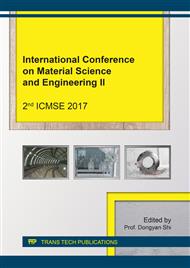[1]
B. Huang, X. Ban, K. Sun, Z. Ma, Y. Mei, W. Jiang, B. Lin, Y. Sun, Thermally activated delayed fluorescence materials based on benzophenone derivative as emitter for efficient solution-processed non-doped green OLED, Dyes Pigm. 133 (2016) 380-386.
DOI: 10.1016/j.dyepig.2016.06.025
Google Scholar
[2]
X. Li, T. N. Zang, H. J. Chi, Y. Dong, G. Y. Xiao, D. Y. Zhang, Multifunctional phosphorescent iridium (III) complexes based on 2-phenylbenzothiazole derivative for highly efficient organic light-emitting diodes, Dyes Pigm. 106 (2014) 51-57.
DOI: 10.1016/j.dyepig.2014.02.025
Google Scholar
[3]
S. Wu, M. Aonuma, Q. Zhang, S. Huang, T. Nakagawa, K. Kuwabara, C. Adachi, High-efficiency deep-blue organic light-emitting diodes based on a thermally activated delayed fluorescence emitter, J. Mater. Chem. C. 2 (2014) 421-424.
DOI: 10.1039/c3tc31936a
Google Scholar
[4]
M. Y. Wong, E. Zysman‐Colman, Purely Organic Thermally Activated Delayed Fluorescence Materials for Organic Light‐Emitting Diodes, Adv. Mater. (2017) 1605444-160598.
DOI: 10.1002/adma.201605444
Google Scholar
[5]
H. Wang, L. Xie, Q. Peng, L. Meng, Y. Wang, Y. Yi, P. Wang, Novel thermally activated delayed fluorescence materials–thioxanthone derivatives and their applications for highly efficient OLEDs, Adv. Mater. 26 (2014) 5198-5204.
DOI: 10.1002/adma.201401393
Google Scholar
[6]
H. Uoyama, K. Goushi, K. Shizu, H. Nomura, C. Adachi, Highly efficient organic light-emitting diodes from delayed fluorescence, Nat. 492 (2012) 234-238.
DOI: 10.1038/nature11687
Google Scholar
[7]
P. Rajamalli, N. Senthilkumar, P. Gandeepan, P. Y. Huang, M. J. Huang, C. Z. Ren-Wu, C. Y. Yang, M. J. Chiu, L. K. Chu, H. W. Lin, A new molecular design based on thermally activated delayed fluorescence for highly efficient organic light emitting diodes, J. Am. Chem. Soc. 138 (2016).
DOI: 10.1021/jacs.5b10950
Google Scholar
[8]
X. K. Chen, S. F. Zhang, J. X. Fan, A. M. Ren, Nature of Highly Efficient Thermally Activated Delayed Fluorescence in Organic Light-Emitting Diode Emitters, J. Phys. Chem. C. 119 (2015) 9728-9733.
DOI: 10.1021/acs.jpcc.5b00276
Google Scholar
[9]
P. Data, P. Pander, M. Okazaki, Y. Takeda, S. Minakata, A. P. Monkman, Dibenzo[a, j]phenazine-Cored Donor–Acceptor–Donor Compounds as Green-to-Red/NIR Thermally Activated Delayed Fluorescence Organic Light Emitters, Angew. Chem. 128 (2016).
DOI: 10.1002/ange.201600113
Google Scholar
[10]
V. S. Thirunavukkarasu, M. Donati, L. Ackermann, Hydroxyl-Directed Ruthenium-Catalyzed C–H Bond Functionalization: Versatile Access to Fluorescent Pyrans, Org. Lett. 14 (2012) 3416-3419.
DOI: 10.1021/ol301387t
Google Scholar
[11]
R. B. N. Baig, R. S. Varma, A highly active and magnetically retrievable nanoferrite–DOPA–copper catalyst for the coupling of thiophenols with aryl halides, Chem. Commun. 48 (2012) 2582-2584.
DOI: 10.1039/c2cc17283f
Google Scholar
[12]
S. Y. Lee, C. Adachi, T. Yasuda, High‐Efficiency Blue Organic Light‐Emitting Diodes Based on Thermally Activated Delayed Fluorescence from Phenoxaphosphine and Phenoxathiin Derivatives, Adv. Mater. 28 (2016) 4626-4631.
DOI: 10.1002/adma.201506391
Google Scholar


